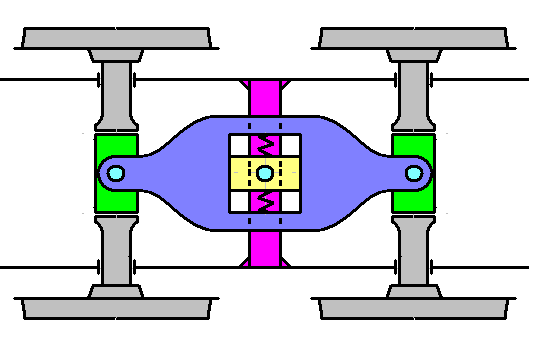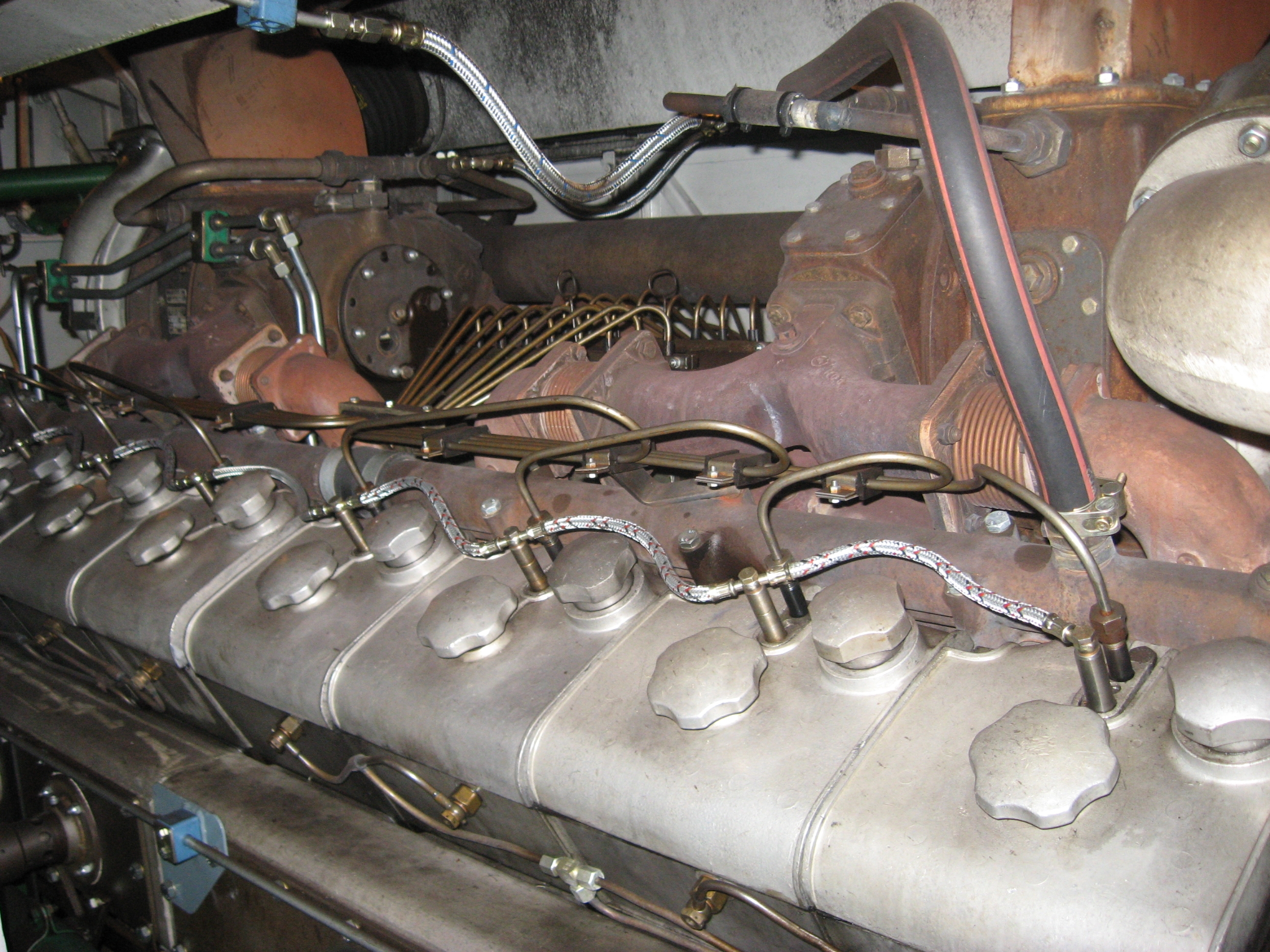|
Édouard Beugniot
Édouard Beugniot (1822-1878) was a French engineer, designer of the Beugniot lever, a system for articulating the driving axles of railway locomotives. Career Jean Gaspard Edouard Beugniot was born in Masevaux on 12 February 1822. His parents were Jean Claude Beugniot, who worked at the spinning factory of Nicolas Koechlin in the same city, and Henriette Berger-Pfeffel. At age 15, Édouard Beugniot left Masevaux to go to Mulhouse as an apprentice mechanic in the foundry of André Koechlin & Cie, whose founder André Koechlin was the first cousin of Nicolas Koechlin. In 1844, Édouard Beugniot was 22 when he was appointed head of the locomotive department of André Koechlin & Cie. Two years later he qualified as a civil engineer. When the company became Société Alsacienne de Constructions Mécaniques, he directed the locomotive construction sector at the Mulhouse plant and worked with Alfred de Glehn. Beugniot designed a system for articulating the driving axles of railway loco ... [...More Info...] [...Related Items...] OR: [Wikipedia] [Google] [Baidu] |
Beugniot Lever
The Beugniot lever (''Beugniot-Hebel'') is a mechanical device used on a number of locomotives to improve curve running. It was named after its inventor Édouard Beugniot. Overview Around 1860, when Beugniot was the chief engineer at the firm of André Koechlin, André Koechlin & Cie. in Mulhouse, he developed a system whereby Wheelset (railroad), wheelsets are housed in pairs in the locomotive frame, with side-play, and connected by a lever. These levers are fixed to the frame in the centre and thus enable the sideways movement of the connected axles in opposite directions. In this way, instead of being fixed in the frame, the axles are able to move sideways rather like a bogie, but clearly nowhere near as much. On locomotives with a side rod drive, the axle side-play is balanced using longer coupling pins (''Kuppelzapfen'') on which the coupling rods are also able to move sideways. Operation On running round a bend, the first axle is pushed sideways by the curve of the rails an ... [...More Info...] [...Related Items...] OR: [Wikipedia] [Google] [Baidu] |
Masevaux
Masevaux ( is the French name of Mà smìnschter (), a former Communes of France, commune in the Haut-Rhin Departments of France, department in north-eastern France. Demographic evolution History On 1 January 2016, it was merged into the new commune Masevaux-Niederbruck. 22 December 2015 Famous Residents The organist and composer Jacques-Louis Battmann (1818–1886) was born in Masevaux.See also * Communes of the Haut-Rhin départementReferences Former communes of Haut-Rhin {{HautRhin-geo-stub ...[...More Info...] [...Related Items...] OR: [Wikipedia] [Google] [Baidu] |
Nicolas Koechlin
The Koechlin family (; ; originally also spelled Köchlin and Köchli) is a French Alsatian family of Swiss origin originally hailing from Stein am Rhein near Schaffhausen. They expanded over several generations via Zurich and emigrated to Mulhouse where they acquired substantial wealth in the textile industry and held several public offices as politicians, military officers and judges. In 1782, the formerly Swiss family, remigrated to Switzerland and took Swiss citizenship in Basel. There they became members of the social upper class as well, mostly through marrying into families of the Daig (Switzerland). Through these alliances with families such as the Merian family, Burckhardt family and Geigy family they became industrialists, clergy and politicians. Most notably they were involved in J.R. Geigy (presently Novartis) and responsible to turning the firm into a global concern. In 1874 and 1886, a second and third line of the Alsatian Koechlin families, became citizens i ... [...More Info...] [...Related Items...] OR: [Wikipedia] [Google] [Baidu] |
Mulhouse
Mulhouse (; ; Alsatian language, Alsatian: ''Mìlhüsa'' ; , meaning "Mill (grinding), mill house") is a France, French city of the European Collectivity of Alsace (Haut-Rhin department, in the Grand Est region of France). It is near the France–Switzerland border, border with Switzerland and France–Germany border, Germany. It is the largest city in Haut-Rhin and second largest in Alsace after Strasbourg. Mulhouse is known for its museums, especially the (also known as the , 'National Museum of the Automobile') and the (also known as , 'French Museum of the Railway'), respectively the largest automobile and railway museums in the world. An industrial town nicknamed "the French Manchester", Mulhouse is also the main seat of the Upper Alsace University, where the secretariat of the European Physical Society is found. Administration Mulhouse is a Communes of France, commune with a population of 108,312 in 2019. [...More Info...] [...Related Items...] OR: [Wikipedia] [Google] [Baidu] |
André Koechlin
André Koechlin (1789–1875) was a French people, French industrialist and the railroad equipment maker from the Koechlin family. Life André Koechlin was born in France to the Koechlin family, where he was the grandson of Samuel Koechlin, son-in-law of Daniel Dollfus-Mieg, head of the Dollfus-Mieg textile company and the cousin, first cousin once removed of structural engineer, Maurice Koechlin, who is an ancestor of actress Kalki Koechlin. Under his lead, between 1818 and 1826, the company became the leading textile company of Mulhouse. Turning in 1826 to the building of machinery for the textile industry, Koechlin became knowledgeable in the fabrication of steam machines and started making railroad equipment. The firm prospered and in 1839 already employed 1,800 people. By 1842, they were the largest French locomotive maker, having built 22 of them by then. This rose rapidly, and in 1857 alone, they made 91 locomotives. They stayed one of the six large French locomotive const ... [...More Info...] [...Related Items...] OR: [Wikipedia] [Google] [Baidu] |
Société Alsacienne De Constructions Mécaniques
The Société Alsacienne de Constructions Mécaniques (the Alsatian Corporation of Mechanical Engineering), or SACM, is an engineering company with its headquarters in Mulhouse, Alsace, which produced railway locomotives, textile and printing machinery, diesel engines, boilers, lifting equipment, firearms and mining equipment. SACM also produced the first atomic reactor at Marcoule. History Foundation The company was founded by André Koechlin in 1826 to produce textile machinery. In 1839, he opened a factory to build railway locomotives at Mulhouse in Alsace. The business grew rapidly but in 1871, the annexation of Alsace-Lorraine by Germany, brought about the transfer of some production to Belfort in France. In 1872 the company merged with the Graffenstaden company of Illkirch-Graffenstaden (a suburb of Strasbourg) to form SACM. Alsthom The new company diversified into the production of boilers, steel equipment, printing equipment, compressors, firearms and other engi ... [...More Info...] [...Related Items...] OR: [Wikipedia] [Google] [Baidu] |
Alfred De Glehn
Alfred George de Glehn (15 September 1848 – 8 June 1936) was a notable English-born French designer of steam locomotives and an engineer with the Société Alsacienne de Constructions Mécaniques (SACM). His steam engines of the 1890s combined elegance, high speed, and efficiency. De Glehn's express locomotives were first used on the Nord Railway and on the boat trains from Calais to Paris, where they impressed passengers with their speed. He invented the Glehn system of compounding, and De Glehn types were built in large numbers in France, and were also built in smaller numbers in Belgium, Germany, New Zealand, and Russia, see Compound locomotive. Compounding lost favour from the 1900s, being replaced by superheating. However André Chapelon rebuilt many of the French De Glehn compounds from 1929 onwards. Personal life Alfred De Glehn was one of the twelve children of Robert von Glehn, a Prussian nobleman originally from the Baltic provinces, whose family had estates near Tal ... [...More Info...] [...Related Items...] OR: [Wikipedia] [Google] [Baidu] |
1822 Births
Events January–March * January 1 – The Greek Constitution of 1822 is adopted by the First National Assembly at Epidaurus. * January 3 – The famous French explorer, Aimé Bonpland, is imprisoned in Paraguay on charges of espionage. * January 7 – The first freed slaves from the United States arrive on the west coast of Africa, founding Monrovia on April 25. * January 9 – The Portuguese prince Pedro I of Brazil decides to stay in Brazil against the orders of the Portugal's King João VI, beginning the Brazilian independence process. * January 13 – The design of the modern-day flag of Greece is adopted by the First National Assembly at Epidaurus, for their naval flag. * January 14 – Greek War of Independence: Acrocorinth is captured by Theodoros Kolokotronis and Demetrios Ypsilantis. * February 6 – The Chinese junk '' Tek Sing'' sinks in the South China Sea, drowning more than 1,800 people on board. The wreckage will not be located until 1999. * Fe ... [...More Info...] [...Related Items...] OR: [Wikipedia] [Google] [Baidu] |
1878 Deaths
Events January * January 5 – Russo-Turkish War: Battle of Shipka Pass IV – Russian and Bulgarian forces defeat the Ottoman Empire. * January 9 – Umberto I becomes King of Italy. * January 17 – Russo-Turkish War: Battle of Philippopolis – Russian troops defeat the Ottoman Empire. * January 23 – Benjamin Disraeli orders the British fleet to the Dardanelles. * January 24 – Russian revolutionary Vera Zasulich shoots at Fyodor Trepov, Governor of Saint Petersburg. * January 28 – In the United States: ** The world's First Telephone Exchange begins commercial operation in New Haven, Connecticut. ** ''The Yale News'' becomes the first daily college newspaper in the U.S. * January 31 – Turkey agrees to an armistice at Adrianople. February * February 2 – Greece declares war on the Ottoman Empire. * February 7 – Pope Pius IX dies, after a 31½ year pontificate (the longest definitely confirmed). * February 8 &nd ... [...More Info...] [...Related Items...] OR: [Wikipedia] [Google] [Baidu] |
French People In Rail Transport
French may refer to: * Something of, from, or related to France ** French language, which originated in France ** French people, a nation and ethnic group ** French cuisine, cooking traditions and practices Arts and media * The French (band), a British rock band * "French" (episode), a live-action episode of ''The Super Mario Bros. Super Show!'' * ''Française'' (film), a 2008 film * French Stewart (born 1964), American actor Other uses * French (surname), a surname (including a list of people with the name) * French (tunic), a type of military jacket or tunic * French's, an American brand of mustard condiment * French (catheter scale), a unit of measurement * French Defence, a chess opening * French kiss, a type of kiss See also * France (other) * Franch, a surname * French Revolution (other) * French River (other), several rivers and other places * Frenching (other) * Justice French (other) Justice French may refer to: * C. ... [...More Info...] [...Related Items...] OR: [Wikipedia] [Google] [Baidu] |





